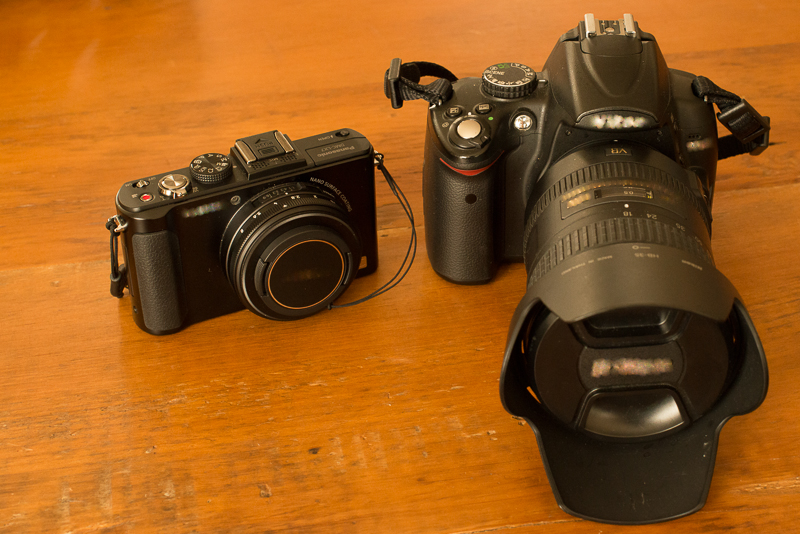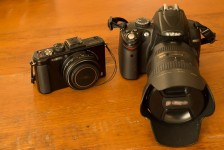PHOTOGRAPHY TIPS … choose a new camera?
Point & Shoot Digital Camera or a DSLR
You asked – here it is. I receive so many questions about photography that I decided to write about a few topics in a loose sequence of blogs. I will touch on different topics such as how to store & organize pictures on your computer, understanding aperture, speed, ISO, lenses, and shooting subjects and objects. I encourage you to send me feedback and questions. I am happy to answer any of your questions and give my opinion.
Before we jump into technique, let’s think about what type of camera is right for you? Do you want to buy a digital point & shoot camera or a DSLR (Digital Single-Lens Reflex)? (The best is to have both one day 🙂
In my opinion the most important questions to ask yourself are the following: “Do I love to take pictures?” ,”Do I like to create special, interesting pictures?”, “DO I LIKE TO HAVE CONTROL OVER MY IMAGES?” or even more “Do I like to experiment with composition and post-processing?”. If you answered 2 or 3 with YES, then I think you should look into a DSLR. Some high end point & shoot cameras let you shoot in manual mode, but they cannot replace a DSLR.
I have a DSLR camera with different lenses which I use for serious work and I have a higher end point and shoot which I carry with me almost all the time. Needless to say that is the best you can have.
The following points speak for a DSLR or Point & Shoot.
- A Point and Shoot camera is small and you can carry it with you all the time, like an iPhone. A DSLR is bigger and you need a camera bag or hang it around your neck or shoulder. Of course it is also heavier.
- Point & Shoot cameras are affordable, costing between $100 and $500. They have no viewfinder but a built-in LCD display. Everything is built in including lots of scene programs like portrait, night-shots, close-up ….
- Point & Shoot cameras however have a shutter delay. How often did you take a picture of your child or dog and when you looked at the picture you only see a foot or the tale. That is the shutter delay.
- How often did you take a picture of flowers and then you say “why don’t my pictures look like the ones I see in magazines? …… okay now we talk about having a DSLR.
- DSLR kits start at $500.- and go up to $2000.-. When you buy just a DSLR body and then add prime lenses the price starts at $1000.-
- Entry level DSLR kits however give you already the chance to CONTROL your picture taking.
- One important thing to know is “you invest in lenses”. Lenses are the most important items. Camera bodies nowadays are almost like computers. When you buy them a new model is already out. Lenses stay. I still have a tele lens I bought in 1980 and it is still rated as one of the top lenses. That said personally I wouldn’t by a kit. By the camera body and lens separately.
- Nikon or Canon or ….? Nikon and Canon are the leaders. I always had Nikon and I am very happy with what I have. Friends of mine are happy with Canon.
- In the film days you bought a camera body and one or two fix lenses. If you are serious learning more about photography I would suggest you purchase a camera body and a prime lens 50mm/1.4. (Nikon sells it for approx. $450.-) This lens will still be perfect in case you upgrade one day from DX-format to FX (full frame). The sensor size or a DX is 16x24mm while the sensor size of a FX is 24x36mm – almost 2.4 times bigger!
- Everybody gets confused about mega-pixels. Unless you are planning to blow your picture up to cover a part of your wall 10-12 mega-pixels are enough. However it is also important to know that a Point & Shoot camera with 10 megapixels does not reach the same quality level as a DSLR with 10 megapixel. The reason is that the size of the image sensor at DSLR cameras are bigger.
Further advantages of DSLR cameras:
- Flexible. The ability to change lenses open up a new world of possibilities.
- Image quality: Bigger sensors result in better quality. Bigger sensors also allow you to increase the ISO which is a big advantage in low light.
- Speed: DSLRs are fast. Switching it on – focussing and taking the picture – there is no noticeable shutter lag.
- Optical viewfinder: You get what you see and you see what you want even in bright sunny winter landscape in the Swiss Alps.
- Lenses & Quality: From Nikon you can choose from a variety of more than 60 lenses. Fix lenses in general have better optical quality. Top zoom lenses are as good as fix lenses. Those zoom lenses however are above $1000.-. Companies like Sigma, Tokina, Tamron have good quality lenses as well and fit for Nikon or Canon and in general are less expensive.
- Manual control: You control how you want your picture to turn out.
- Depth of field: It opens so much creativity and gives the pictures that special feeling or look.
The bottom line in deciding what you want is how much can you spend?
Did that help? Enjoy shopping for your new camera!


1 Comment